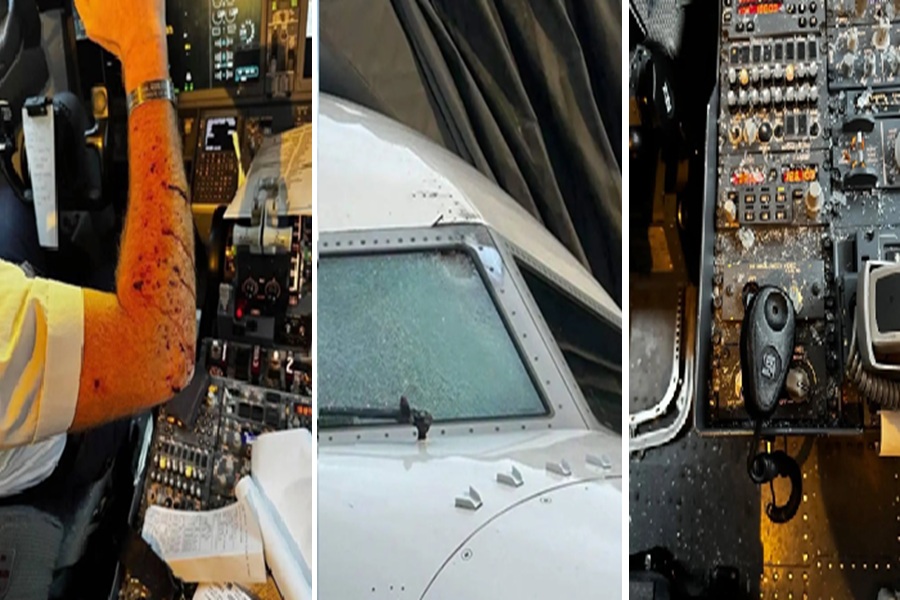
It now appears a collision with a weather balloon and not a meteor is likely for the damage and injury that occurred on a United 737 flight from Denver to Los Angeles days ago. We connected with the CEO of a weather balloon company that believes his equipment may be involved in this incident.
On Thursday, October 16, 2025, a Boeing 737 MAX 8 flight traveling from Denver to Los Angeles as United flight 1093 with 140 souls on board was forced to divert to Salt Lake City after a cracked windshield was discovered midair. The incident occurred at an altitude of 36,000 feet and a pilot was injured in the incident.
Due to the altitude and lack of weather in the area, initial theories included a strike by a meteor or some other space debris. If a meteor strike was to blame, it would be an aviation first. There’s been no record of any space debris strike on a commercial aircraft anywhere in the world. A 2023 FAA report found there to be an annual 0.1% chance that falling space debris would cause a single global aviation casualty, which yields a risk to a passenger of about 1 trillion to one.
Photographs shared by a United employee show damage inside and outside of the aircraft, along with a bloodied pilot’s arm, apparently injured by shattered glass that entered the cockpit and also littered the center console.

A 737 cockpit windshield is made of a multi-layered “sandwich” of materials, typically consisting of an outer glass layer for weather resistance, a middle layer of stretched acrylic or a heating element for de-icing, and an inner glass layer that acts as the primary load-bearer. These layers are bonded together with other materials like vinyl or urethane to ensure strength, durability, and safety, and have specialized coatings.
WindBorne systems CEO and co-founder John Dean saw the images online and wrote on X, “Yes, I think this was a WindBorne balloon. We learned about UA1093 and the potential that it was related to one of our balloons at 11pm PT on Sunday and immediately looked into it. At 6am PT, we sent our preliminary investigation to both NTSB and FAA, and are working with both of them to investigate further.”
According to their website, Windborne writes, “By instrumenting the environment and advancing forecasts, WindBorne is building a planetary nervous system to make the world safer and more sustainable for everyone.”
As part of its business, WindBorne Systems designs, builds, and operates its own weather balloons. It is a company that uses these long-duration, “smart” balloons to collect atmospheric data for agencies like the National Weather Service and partners with organizations such as NOAA, the U.S. Air Force, and the UCSD Scripps Institute of Oceanography. These Global Sounding Balloons (GSBs), which are designed to stay aloft for up to two weeks and operate autonomously. collect detailed atmospheric data and can change altitude in real-time to create vertical profiles of the atmosphere.
Dean wrote on X that his company goes through great lengths to prevent mishaps like this one from happening.
“We file NOTAMs, follow all specifications required by FAA 14 CFR part 101, and share all live balloon positions with the FAA via API and our website…. We have been coordinating with the FAA for the entire history of the company….The system is designed to not pose a risk to human life in the worst case event of a collision. This is what the FAA 101 and ICAO weight limits are for. And indeed, there were no serious injuries and no depressurization event to my knowledge as a result of the collision.”
Dean added, “However, I’m still surprised to see spallation of the windshield on the inside. I find this extremely concerning, and unacceptable in the case of a collision, regardless of what the official regulations are. It resulted in injury to a pilot, which I’m simply not okay with whatsoever.”
“As mentioned, we are working closely with the FAA on this. We haven’t yet received any operational guidance. Regardless, we just deployed a software change to minimize time at active flight levels and are manually checking it across the full constellation. Additionally, we are actively working on new hardware designs to reduce impact force magnitude and concentration.”
We asked Dean how heavy the weather balloon payload is. The payload, which consists of a bag of sand, is roughly the size of a banana. Dean replied to us, “It’s bout 1kg fully loaded with ballast.” 1 kg is roughly 2.2 pounds.
Others on X have lauded Dean for his transparency and openness, including other scientists who have volunteered to improve his company’s technology further to avoid future potential aircraft collisions.